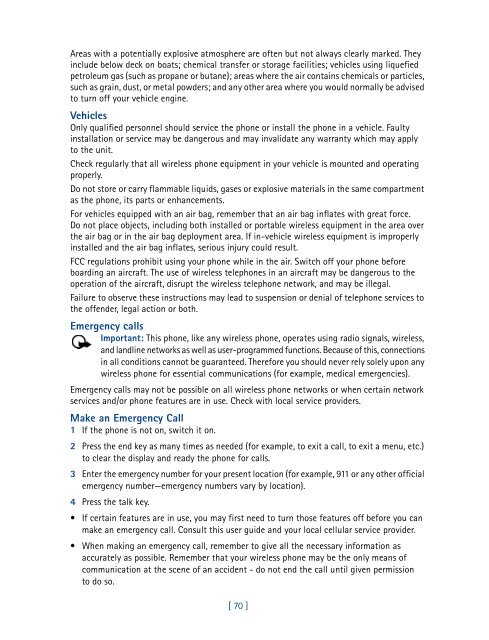Nokia 3585i User Guide (PDF) - STi Mobile
Nokia 3585i User Guide (PDF) - STi Mobile
Nokia 3585i User Guide (PDF) - STi Mobile
You also want an ePaper? Increase the reach of your titles
YUMPU automatically turns print PDFs into web optimized ePapers that Google loves.
Areas with a potentially explosive atmosphere are often but not always clearly marked. They<br />
include below deck on boats; chemical transfer or storage facilities; vehicles using liquefied<br />
petroleum gas (such as propane or butane); areas where the air contains chemicals or particles,<br />
such as grain, dust, or metal powders; and any other area where you would normally be advised<br />
to turn off your vehicle engine.<br />
Vehicles<br />
Only qualified personnel should service the phone or install the phone in a vehicle. Faulty<br />
installation or service may be dangerous and may invalidate any warranty which may apply<br />
to the unit.<br />
Check regularly that all wireless phone equipment in your vehicle is mounted and operating<br />
properly.<br />
Do not store or carry flammable liquids, gases or explosive materials in the same compartment<br />
as the phone, its parts or enhancements.<br />
For vehicles equipped with an air bag, remember that an air bag inflates with great force.<br />
Do not place objects, including both installed or portable wireless equipment in the area over<br />
the air bag or in the air bag deployment area. If in-vehicle wireless equipment is improperly<br />
installed and the air bag inflates, serious injury could result.<br />
FCC regulations prohibit using your phone while in the air. Switch off your phone before<br />
boarding an aircraft. The use of wireless telephones in an aircraft may be dangerous to the<br />
operation of the aircraft, disrupt the wireless telephone network, and may be illegal.<br />
Failure to observe these instructions may lead to suspension or denial of telephone services to<br />
the offender, legal action or both.<br />
Emergency calls<br />
Important: This phone, like any wireless phone, operates using radio signals, wireless,<br />
and landline networks as well as user-programmed functions. Because of this, connections<br />
in all conditions cannot be guaranteed. Therefore you should never rely solely upon any<br />
wireless phone for essential communications (for example, medical emergencies).<br />
Emergency calls may not be possible on all wireless phone networks or when certain network<br />
services and/or phone features are in use. Check with local service providers.<br />
Make an Emergency Call<br />
1 If the phone is not on, switch it on.<br />
2 Press the end key as many times as needed (for example, to exit a call, to exit a menu, etc.)<br />
to clear the display and ready the phone for calls.<br />
3 Enter the emergency number for your present location (for example, 911 or any other official<br />
emergency number—emergency numbers vary by location).<br />
4 Press the talk key.<br />
• If certain features are in use, you may first need to turn those features off before you can<br />
make an emergency call. Consult this user guide and your local cellular service provider.<br />
• When making an emergency call, remember to give all the necessary information as<br />
accurately as possible. Remember that your wireless phone may be the only means of<br />
communication at the scene of an accident - do not end the call until given permission<br />
to do so.<br />
[ 70 ]


